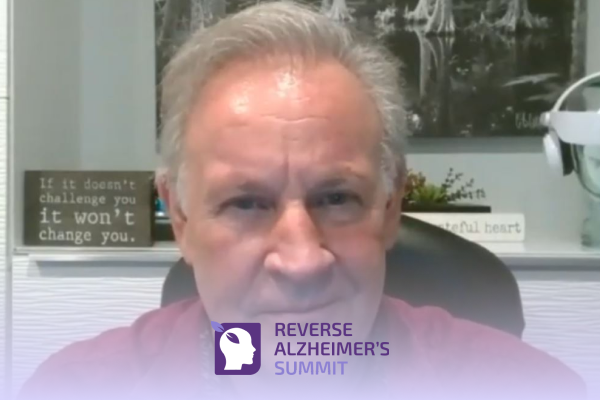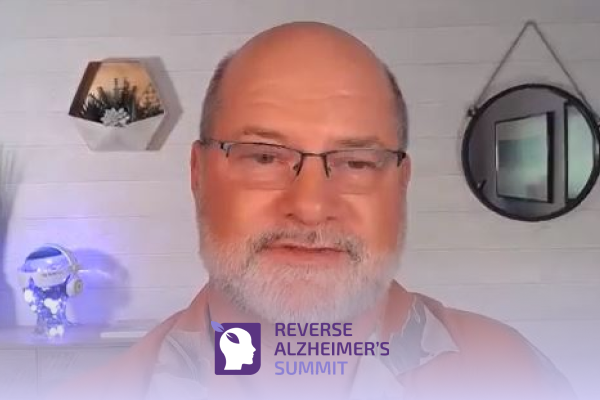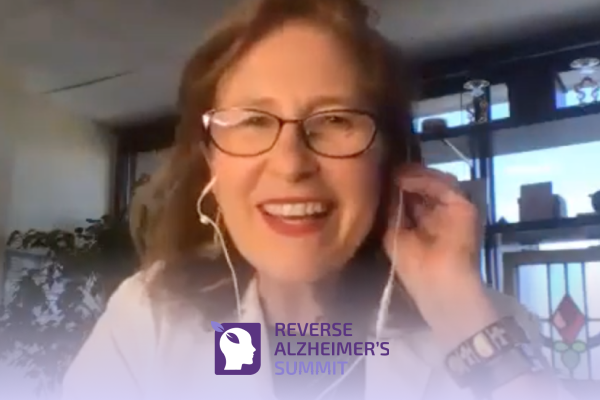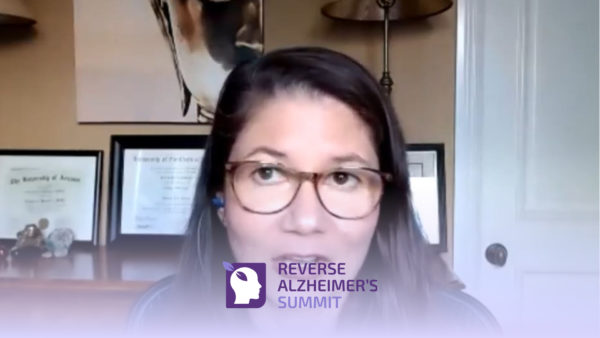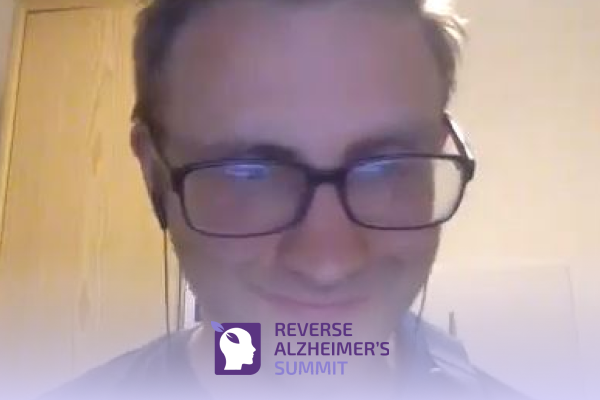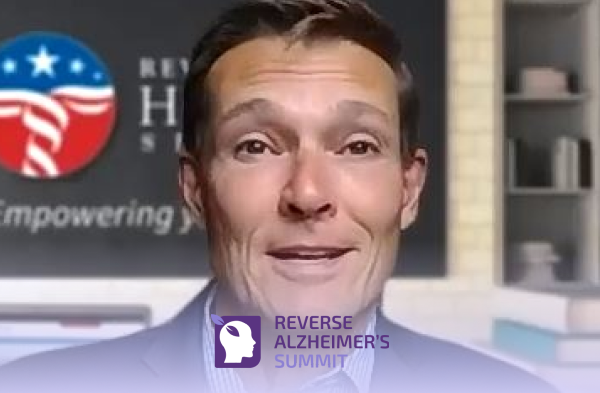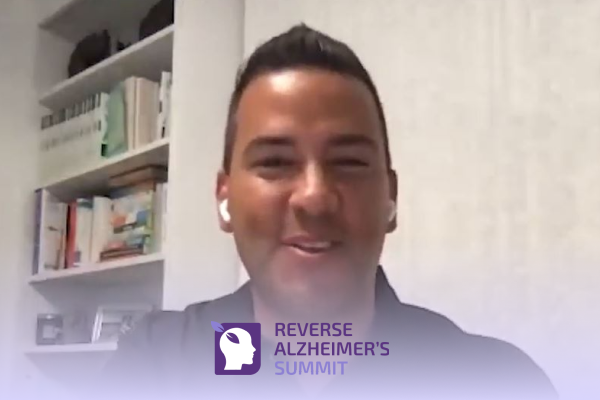Join the discussion below

Dr. Heather Sandison is the founder of Solcere Health Clinic and Marama, the first residential care facility for the elderly of its kind. At Solcere, Dr. Sandison and her team of doctors and health coaches focus primarily on supporting patients looking to optimize cognitive function, prevent mental decline, and reverse... Read More

Kelly Miller, NMD founded Health Restoration in 2013 based on his belief that a natural, synergistic approach to health care is the optimum approach to addressing the health care issues people face on a daily basis. He is considered an expert on the multi-disciplinary treatment of chronic pain and inflammation, and... Read More
Heather Sandison, N.D.
Welcome back to the Reverse Alzheimer’s Summit. I have Dr. Kelly Miller here with me today and he believes the whole is greater than the sum of its parts. This informs his clinical experience with saving your brain. His educational background at acupuncture, chiropractic, naturopathy, functional diagnostic medicine, aging and regenerative medicine and now, functional neurology allows for a multifaceted analysis and insight into the brain’s anatomy, physiology and biochemistry to help his patients restore long lost health, develop a strategy for functional longevity and improve or restore impaired brain function.
His understanding of how to combine all of these disciplines produces outstanding outcomes for his members and this educational background coupled with 40 years of clinical practice makes him an ideal brain health coach. Dr. Miller, thank you so much for joining us. I know that our listeners can tell why I’ve invited you. I certainly have experienced in my clinical practice as well as at Marama that the more comprehensive we can be with our approach, the better the outcomes. And who better to tell us about all of these approaches and how to put them together than you.
Kelly Miller, NMD
Thank you, kind words. So nice to meet you in-person, seeing you face-to-face, and thank you for having me on.
Heather Sandison, N.D.
Thanks for taking time. Thank you so, so much for taking the time. So I’m really curious. This is the first time that we’re meeting in-person and I’ve ordered your book, and so I’m learning a bit from that, but I don’t know your story. How did you become interested in brain health and dementia?
Kelly Miller, NMD
Drugs, sex, rock, and roll and rugby, no. I grew up in the, actually I had a lot of brain trauma. I had played a couple of car crashes where I was knocked unconscious, and then I played rugby for 21 years. And so I was probably involved in 10,000 tackles, so I had a lot of repetitive, and I was very experimental in the ’60’s too, so that may have played a role. But anyway, I was in my mid 50s and I was starting to have some cognitive issues and not remembering things that I knew I should, like bread and butter things that we know, like in our practice, and then also just like I’m reviewing, we’ve been to France and I’m looking at these pictures and I can’t remember well the name of the places and things like that.
So I started researching natural therapeutics on memory and cognitive and things like that, and I spent three years researching that and I published a book called “Saving Your Brain: Causes, Prevention, and Reversal of Alzheimer’s and Dementia.” So yeah, it was basically trying to save myself, I guess, in there and doing that, and there’s actually a lot of research out there and Dr. Bredesen’s book actually came out like one month before mine did. I think he sold a few more copies than I did, but, a lot of the commonalities in there, in my book, I have saving your brain as an acronym for each thing, like we talk about early sleep. His big are infections, environmental issues. And so all those are encompassed upon mine as well. And so a lot of commonality overlap in the two books.
Heather Sandison, N.D.
That’s great. So, yeah, what did you learn? What were the things, this is a very personal journey for you, so what are the things that you learned as you were researching for the book and what did you put into practice? What did you find?
Kelly Miller, NMD
Well, yeah, so we looked at all different kinds of things. So in the acronym S is for sleep. Sleep is really big, and we looked at that. It was very important getting into the delta sleep, and we actually know that the brain shrinks and it has a lymphatic system and gets a lot of the bad stuff out and if we don’t get into that delta sleep, then we can’t clean our brain. And I think the biggest enlightened much for me was infections and their impact on the brain. And being a natural physician, we deal with people with infections, but certainly, we don’t prescribe antibiotics and things like that.
And one of the things I was a big enlightening to me was that I found out I had a mold infection, which I’m sure that was way compounding things. And the more I learned about mold, the more scared I am about it for patients because mold is way more prevalent than we think, and it’s not being checked by allopathic doctors, it’s not even their wheelhouse and this will eat up your gray matter, it will destroy your brain and it will cause atrophy. I have patients that have lost 70% of their matter in certain areas from mold infection. And it’s interesting, the people that get, and you get into different subgroups, you only have a Lyme group, but there’s a lot of similarities between the people that are really susceptible to Lyme and they can’t get over it, and a lot of them get mold infections, and then also then you have this subset of EMF sensitivity, European model has about 20%. There’s a lot of common genetics in those, so lots of times those people have a trifecta, they’ve got Lyme, they got mold, they got EMF sensitivity and they’re not functioning well at all.
Heather Sandison, N.D.
Yeah, I would echo that. I see a lot of the overlap in those populations as well, and I would agree that I think mold is one of the hidden and very common causes of dementia and also a very reversible one. So I’m curious how you direct your clients, your patients to find out if maybe mold is a contributing factor for them.
Kelly Miller, NMD
Yeah, we have them first take this, the visual contrast test that’s on www.survivingmold.com. And I think it has like a 92% correlation, and if that’s positive, then we’ll follow up then with a mycotoxin test. I use great plains, usually, urinalysis, and then so we kinda quantify it and then we, I’ve had very good success using biocide protocol and I have colleagues that use Cellcore protocol, so I just, it’s one of those things that you use and it works for you so you don’t experiment with something else but we’ve had a lot of people clear up with the biocide.
Heather Sandison, N.D.
That’s so interesting, so I use a lot of real time, and real-time testing, but similar mycotoxin testing and then I’ve actually had a few patients asking me about Cellcore recently, and I have no clinical experience with it. So like you, I loved to learn about what works, but I’m sort of stuck in what I do because it works. But yeah, see, I looked at the Cellcore site and it has a lot of these patterns that we’re kind of thinking through of detoxifying and like you mentioned, the infections, getting that immune function optimized, maybe getting rid of some parasites, their comprehensive protocol looked, I was very intrigued by it. So I love hearing that somebody else has seen similar things on the opposite coast for me.
Kelly Miller, NMD
Yeah, and then the next patient is responding, I’ll probably gonna try their protocol. So that’ll be that. A friend of mine, Kyle Daigle in Lake Charles, Louisiana uses Cellcore a lot. And he’s very happy with it.
Heather Sandison, N.D.
Oh, that’s great to know. So would you say his name again? I know there’s gonna be listeners of the summit from all over the country, so I know they’ll have you to contact in Florida. And what was your colleague’s name in Louisiana?
Kelly Miller, NMD
Kyle Daigle.
Heather Sandison, N.D.
Great, great.
Kelly Miller, NMD
World-class doctor.
Heather Sandison, N.D.
Oh, fantastic, the world needs more of those.
Kelly Miller, NMD
Absolutely.
Heather Sandison, N.D.
So what else did you find out and what else have you implemented since your book was published?
Kelly Miller, NMD
Well, I think I’ve, one of the tools I use is a BrainTap and I use try to do that every day, sometimes I don’t get it, sometimes I’ll do five and like back-to-back if I got a break in over lunch, but that definitely distress my brain and I had, I do brain mapping and neural feedback. So brain mapping, we can actually measure your brain speed. So one of the things I was able to do is using alpha is actually speed up my brain. And I actually was talking a little faster, so yeah, I was talking really, I grew up in Arkansas, so I can play [Inaudible] like, talk real slow, no, but I was, I actually, you hear yourself, like five years ago and then all of a sudden you get a new recording and you do this, and I had a lot more life again in my voice and it was a little faster and things.
So that’s one of the tools I use and I use that on every patient, that’s one of the things for home therapy. So we have in office therapies, then we have a home therapy. So home therapies would be nutrition, supplementation, some of my patients will need primitive reflex exercises, core strength exercises, really big emphasize that, especially we’re talking here more on the aging brain, but I would like to take off a little bit on the primitive reflexes, ’cause this is something that, share with other people out there, we think of primitive reflexes many times in the ADHD, autism spectrum and for our listeners, primitive reflexes, like when you put your finger in the palm of a baby’s hand, it would grasp it.
But usually that will go away at like four months. There’s other things like if you touch the cheek of a child, they’ll turn, there’s about 10 of these and they become integrated into the brainstem. And this starts the polyvagal system. When we’re born, we only have a sympathetic nervous system, okay? So we have to develop our parasympathetic through the vagus nerve and the parasympathetic is our rest and digest. So all we have as an accelerator, we don’t have a braking system for our nervous system. So when these primitive reflexes don’t become integrated, it has causes of inhibition in the parasympathetic nervous system and the vagus nerve. And this is something that’s very common, we find a lot of people with brain problems.
So if these primitive reflexes can become integrated and they can emerge again after a physical trauma to the brain, or like a mold infection, and what will happen is some of these in our dementia patients, if you’ll, I don’t know if you check this, but if you start checking the rooting reflex, that’s not reflex, the Apollo mental reflex. So with this, you’ll stimulate this and their chin will kind of quiver and these reflexes are overwritten by the frontal cortex. So you absolutely know that this person has a frontal cortex weakness when these re-emerge, okay? And you can, that’s one of the indicators you can see is their frontal cortex strengthening by the disappearance of these primary refluxes. So this is something I didn’t know when I first started dealing with the aging brain, that’s always something I’ve found in the last 18 months. And so we always check the primitive reflexes in these aging.
Heather Sandison, N.D.
How fascinating. And this is, we are talking about using brain tap and EGS and neurofeedback to help balance the autonomic nervous system, get better sleep. And then these reflexes are, do I understand correctly that they’re more of a test to see how much of the nervous system is healing? Or is it more to balance the parasympathetic sympathetic nervous system?
Kelly Miller, NMD
Yeah, well, the presence of a primitive reflex means automatically there’s an under-development in the polyvagal system, okay? So one of the things we do is we try to integrate these and we integrate them and we use a laser. So we’ll use specifically, we’ll use a red light, 10 Hertz laser on the pons and medulla area right through here on the side of the [Inaudible] and we’ll stimulate those reflexes. And if we can get those, the faster we can get them integrated, the better the autonomic systems were to function. So this has big parameters in that if a aging person starts developing these perimeter reflexes, they’re going to start getting immune problems, digestive problems compoundings, that make sense ’cause they’re gonna get a leaky gut because their digestion, because we need parasympathetic, we need is not the gauge to digest our food. So if it’s not there-
Heather Sandison, N.D.
Got it, got it. So there’s a breakdown of that balance between fight flight, freeze and rest digest and heal, and you stop resting, digesting, and healing when that’s happening and a way to assess for where someone is on that spectrum is by testing these reflexes, how interesting.
Kelly Miller, NMD
Yeah, and moreover with the foundation. So the brain actually develops one on top of the other. So you’ll get these stabilization, like in the stipular system, other things it’s like this foundation is cracked and all these other things that were built on it are starting to crack. So you can really see a big loss overall. Thanks, balanced vestibular system, digestion, immune response.
Heather Sandison, N.D.
What do you recommend people do if they start noticing cognitive changes? What’s the first intervention that you would suggest they make?
Kelly Miller, NMD
Well, I think they needed to get tests like we do a test. Let’s get a score on it. Just like if you’re diabetic, okay? Is your blood sugar 120 or is it 400? You got a little problem, you got a big problem. So let’s see what it is. But the one thing I can say is if someone thinks they have a cognitive problem, they probably do because most of us are oblivious and one of the things, part of the brain is, that is tested like from the Stroop test is a filtering part of the brain. So it’s the basal ganglion talks to our prefrontal cortex. It’s the, should I, or should not, should I shouldn’t I say that, should I shouldn’t I do that. And this is a real common area and that when people have that, they’re kind of oblivious to their behavior, they don’t know that they just said something inappropriate, they didn’t know he did something inappropriate. So sometimes that’s a challenge that people don’t really get, how about now? Their spouses and their other people around them, they get it, but they don’t get it.
Heather Sandison, N.D.
Yeah, I’ve curious about that for a while and I have asked a couple of experts on the summit. I see both, there are dementia patients who are very aware of their cognitive decline and terrified by it. And there are others who are severely declined and completely unaware that they have any decline. Do you know, my hypothesis at this point is that different parts of the brain are being affected. Do you have a strong sense of what’s going on? Is the person that’s unaware just in denial, or is there something else happening?
Kelly Miller, NMD
Well, I think this one part, with the Stroop test is pretty important in that, because it’s a filtering when they have the more filtering problem, you have your perception goes down. So that’s one of the things I see on the ones that do that. And unfortunately, Dr., you’ve probably read it before, the ones that don’t have the perception, like they said, they’re the ones many times that needed the worst and they’re reluctant to take any action and stuff. I’ve had spouse, the husband and wife there, and we’re taking the test and I’m showing the other spouse and I’m having them take it, then that there’s nowhere in there. Like, oh, well, if they wanna do something, it’s up to them. I go, no, they don’t, they’ve lost that ability to make that decision. And we’ve got to take massive action or they’re gonna be changing their diaper pretty soon. So, I mean, I have to-
Heather Sandison, N.D.
It’s so heartbreaking,
Kelly Miller, NMD
You have to put it in a term sometimes that people do that because, and so doing this, I’ve done the light side and more often I didn’t do, we didn’t do enough soon enough. So then getting back there, I would get on it, I’ll get it evaluated and one of the things we do is we look for infections. Another test that we use, I don’t know if you use neural Zoomer plus from Vibrant America, it’s a nice 48 antigen. Okay, is there something going on in the brain that you form an antibody for it? That’s a nice though. Let’s find out what, where the weaknesses are and let’s get them shored up and then we can have recovery.
Heather Sandison, N.D.
Yeah, absolutely. And so another thing we kind of in talking about this autonomic balance, going back to that, it has such a big role to play on the immune system on how well we detox, on how well we sleep, on how well we digest as we’ve discussed, these are a lot of the multifactorial sort of, I think of it now as a dementia verse of the landscape of the things that can cause dementia. And you mentioned how you see kind of this constellation of symptoms that seem to be associated with mold, Lyme, and sometimes this EMF sensitivity, this hypersensitivity, and I’ve come to think of it as like a hypervigilance, almost like that brain is still stuck in that sympathetic nervous system. Maybe we’re not getting the reflexes, like you mentioned, as people become more progressed on dementia, but that there is this tendency to be stuck in a sympathetic state. Do you notice that there is a pattern there as well? And do you have a solution for that, for kind of reprogramming that parasympathetic balance with the sympathetics?
Kelly Miller, NMD
Yeah, well, I mean, we’ve been doing heart rate variability for about five years and we’ve done lots of experimentation, like the PEMF before and after we did for two years, almost every patient before and after we would, before the visit and then we administered therapy then when we see what the outcome was. And then as if they got 80% of people better than we continued using that protocol. But one of the things, when I first did that, I didn’t understand the reflux.
So I’m kind of pounding the table on this a little bit that this could be something hidden that is being missed and more importantly, using the laser to help integrate that. And one of the things that we made big advancement in, with our brain patients is using a laser that specific frequency for the ring, and we’ll get it, we use shed light laser and I think it’s made by Avanti or something like that, but it’s specific. And so you can do red light or infrared in a certain frequency.
So we find our examination, we find the weak area of the brain, and let’s say very common in the aging brain, Alzheimer’s, we’ll see a left hemispheric weakness from the cortex or so they’ll usually have right cerebellar weakness. And so we will stimulate the cerebellum and we made the priodal sensory motor and frontal cortex, where are we gonna be carried to the brain? So the laser increases circulation and it activates the mitochondria, which increases ATP production. So we get increased metabolism on that part of the brain.
Heather Sandison, N.D.
Wonderful, it’s so nice to hear that you guys are incorporating the red light therapies, and the laser therapies, because I agree at Marama, we’ve seen really profound impacts of using red light therapy with our dementia patients as well, it’s always nice to hear that somebody else is getting similar results. The lasers, it kind of sounds techie and even a little out there, I remember when I was training 10, 12 years ago, that they were so expensive and really hard to come by very small surface area that they would cover, and now seeing how they have evolved and how much more accessible they are cost-wise, but also surface area wise, how much benefit you can get in a short amount of time, it’s really impressive. And I’m wondering what you see as sort of the next evolution. What else is on the horizon for treatments in the tech space and in the science space? What are you excited about seeing and implementing both personally and in your clinical practice?
Kelly Miller, NMD
Well, the one thing we’re probably gonna be adding, which we have is oxygen. We were doing, we purchased an EWOT system exercise with oxygen and doing that. And we know hyperbaric helps too. So trying to find something that’s cost effective, the concentrated oxygen is affordable for a patient. In other words, I could get a home unit and you can teach them how to do it. And so one of the things we’re doing is we’re working on, we have patients now that come from all over the country and they may come in for an intensive for one, two, three weeks, four weeks.
And then how do we get them on something at home that can keep them progressing so they can go away and they come back and we can keep fine tuning them. So this is one of the things that we’re looking at. I think the oxygen’s big, PMF is very, very positive. Again, we were talking about trying to initiate that parasympathetic, PMF does a great job of activating the parasympathetic nervous system. And we’ve done a lot of heart rate variability to substantiate that. I think, yeah, whatever we do, know that we do gargling patients to activate the parasympathetic, We have them breathe. Breathing is so important.
We’ll have patients, teach them to breathe while we’re on heart rate variability and what we should do is we should be using our nose to breath in for a count of four, and you want to exhale for a count of eight through our mouth. I said, I wanna hear you exhale, and it’s really important. But if you do that, you see these numbers just, coming up on the heart rate variability, just improving that suddenly you see that their parasympathetic kicking in, most people just don’t breath. So we’ve tried to teach just, five minutes of mindful breathing a couple of times a day to engage that parasympathetic system.
Heather Sandison, N.D.
Phenomenal, so what other kind of positive neuroplastic changes can be looked to make in our brain and how do we get there?
Kelly Miller, NMD
Well, we do a combination of things and we do brain mapping, every 60, 90 days on our patients. And, that shows that actually proves neuroplastic changes in what we’re looking. We do cognitive testing. So again, we have another identifying, we use, many of the therapies are measurable, so we do balance therapy. So we also do timing, so we use something called the interactive metronome. So we’re actually using coordinating vision with ear, one of the things in the agent like a brain is real common to your sounds and your vision and your hearing get confused, you’d get sequencing, I’ve done a lot of testing and show that people love to make mistakes. Like, did they hear three firecrackers go off or did they see two lights go off?
And they often confuse that sequence. So we do a number of different things, the great neuroplastic changes, we use the BrainTap. We did a study using BrainTap that was reduced to some four patients, which we just did BrainTap. And, did a little nutrition and show some very positive changes and improved cognitive function. So they can do it, the brain and then specifically what we do is we do a lot of in our office, we do sensory input. So when we find the weak area, so if we have a left hemispheric weakness, we are going to bombard the right side of the body with light sound and by ritually frequencies. And we’re going to create neuroplastic communication through the sensory, through the cerebellum on the right side, over to the parietal temporal frontal regions. So we’re trying to increase that sensory motor component. And again, that has a very positive effect on the the recovery of the patient.
Heather Sandison, N.D.
Good, wow, how exciting . A lot of these things, they’re like, you need a coach, right? It’s a lot to take on, but it’s also relatively simple. What are you seeing in your practice in terms of implementation, how do you guys support people? What are just the logistics? You mentioned people come from all over the country and do intensives, tell me a little bit more about how you interface with your clients.
Kelly Miller, NMD
Well, we’ve developed something, we have a system called healthy.com, which is a telemedicine and it’s also secure HIPAA compliant. And then what we were doing, we’re putting more and more information up on that. So we were having, we’re showing exercises. Okay, we want you to do whatever this exercise, once you do sit-ups, push-ups, pull-ups, YTA’s with a band or, we have videos up for that. And so sometimes, initially the patient will have to do a video and I’ll have them do different things. Like I’ll have them stand tandem and okay, which way are they going? Have them do a nose, touch their nose, close their eyes, go fast, see if they’re still hitting their nose.
So we’re kind of doing a neurological exam a little bit so we can get an idea of their status and having take some cognitive tests before they come in so we can kind of see what we need to do. So again, you can do that, we do some of that on the back end. So let’s see how you’re doing this now. Let’s see, can you stand with your feet tandem and not fall over now? I used to fall over five seconds. Now you can do that, you got a little wavering, but you can hang in there for 30 seconds, that’s a big improvement.
So the balance is a real big thing that we don’t think about. But when we have so much of our brain is built just to keep us upright and so if we’re not doing well in that department, then it’s not, we only have so much energy for a rig. We used to what 2020 5% of our total fuel allocation is for brain. So if you have one area like that, where people are having balance problems, most people with balance problems are in cognitive climb, early cognitive climb. Their head is forward, they’re leaning forward, there’s a system that is controlled by the frontal cortex or communicates with the frontal cortex.
I won’t get into a big, long name and it’s called the PMRF system, but basically it controls your extensor muscles, okay? So your extensor muscles are what hold us up right, hold the head up, hold us at the waist, on the chiropractor background, we just think, well, they just had biomechanical problems. No, they had a brain problem. These people are leaning over, they got a brain problem because they’re losing the communication to their extensor muscles. And that’s from the frontal cortex. So when people start leaning, that is this another sign of frontal cortex weakness.
Heather Sandison, N.D.
And so then you’re saying what you do are exercises at both in your clinic and then they’re able to do a lot of these at home without the help of like a one on one physical therapist, they can be integrating this and getting the benefit?
Kelly Miller, NMD
Absolutely, yeah, so it’s very important to get these core strength, muscles intact and get that. And so again, you can test it. It’s a very simple system to do so you can just have their thumbs out and you’re just gonna test the strength in their thumbs. You’re gonna have their fingers, you’re just gonna pull their set. And one side will be weaker than the other. You’re gonna check their abductors. You can check their big toe extensor. Now they could have a neurological problem that’s creating a specific weakness in there. But generally these are really quick things you can check to determine if there, which side of the frontal cortex is weaker.
Heather Sandison, N.D.
It’s so interesting ’cause it’s this dementia and even fall risk rate as we age, this takes up massive bandwidth societally, right? In terms of Medicare dollars, caregiver hours, when we think about this, it feels almost insurmountable, right? And billions of dollars go into these issues and particularly into healthcare as we age and what you’re describing, like you just said, it’s very simple, it’s very easy, you just do it, right? And so few people know that this is an option.
So I wanna make sure everyone listening understands where they can find out more. I think you and I, we do this every day and so it’s kind of old habit, like we’re used to this, of course it works. Of course, it’s relatively simple, just do it. And so many of our listeners, right, have been told by a neurologist who is very, well-meaning, very kind, is there to care, but just, they don’t know. They’re not aware that there are these interventions that someone who is at risk of losing independence or going bankrupt because they have so much to pay for because they’re unable to do things independently, they deserve to know that there are options and that there are relatively inexpensive interventions that can be made. So again, tell people how they can find out more about what you have to offer.
Kelly Miller, NMD
Sure, well, we’ve got www.savingyourbrain.com and that’s our website. And then we, that people can connect with, when they scroll down to the healthy.com that’s on there, that’s our teller reporting system. So we have a, you can go online. We actually have, if you go to my website, Natalie’s gonna come up and show that you have a question, so you can ask specific questions, there’s an email capability there, so you can reach out that way. And then our main office number is 8-139-855-190 in Tampa, Florida. And that we use, we book all our locations on that main office.
Heather Sandison, N.D.
Great, and so there’s a Missouri option and a couple of Florida options, and you don’t just work with dementia. You and I are both well aware that we live in an age of accelerating brain imbalances and Alzheimer’s is just one of those. So there’s other kind of neuro imbalances, neurodegenerative diseases and you work with those as well. Tell me kind of what the similarities and the differences are in working with those types of patients.
Kelly Miller, NMD
Well, I think one of the biggest factors for a negative outcome in your brain, long-term is anxiousness, depression. These are epidemic in our society, there’s this report, Blue Cross Blue Shield came out, that they had a 31% increase in early Alzheimer’s. They’ve got a 30% and this last year of 12 to 17 year olds being medicated for anxious depression. So that’s scary. I mean, if you have a 12, 13 year old brain that you’re gonna start medicating and changing neural transmitters and doing things like that, the prognosis for that person to be a functional person in our society is getting pretty low.
So we see moderate to severe ADHD children, a lot of young adults, there’s a lot of young men living with mom and dad still in their 20s and 30s because they have these imbalances, or they may be a little bit on the spectrum. So generally what we see in the younger group in the last 20 years is we see this huge epidemic, a right brain weakness. Our left brain is like our analytical, our practical logical part and generally we’re becoming as a society more and more of that brain.
So, you get to left brain, mom and dad, they get together, they’re more likely to have a right brain weakness. And if that’s not balanced by exercise and things, I was a kid you out run and play, come back in three or four hours. If you’re a couch potato and you’re on the computer as little games, you’re not activating that part. So that right brain is eye contact, need for socialization, need per touch need, and that’s not being nurtured and especially with going through there. So that’s what we see on that side. So we see a lot of that and the aging brains, usually the left hemisphere weakness. So a loss of that ability to be logical and pragmatic and things like that. But they’re epidemic on both ends.
I mean, it’s scary. You’ve got one in 10, children now ADHD and ADHD children become ADHD adults. They may cope with it, but they’re very anxious individuals. And again, most of these people are primitive reflexes, so that’s why they’re anxious, they’re fight flight, they have trouble sleeping. We got 60 million Americans that have insomnia. So it’s a common, there’s a lot of common patterns in here. And a lot of it being related to the autonomic imbalance.
Heather Sandison, N.D.
Right, yeah, so much of what we experienced has to do with our perception of what we’re experiencing. and you talk about that a bit in your book about how Alzheimer’s really involves lifestyle, environment, infections, and perceptions, and having these perceptions, that the anxious perception that we are at risk, that we are being threatened. And especially when that perception is part of the development of our brain really puts us at risk. And I certainly see that in the patients that you were talking about with can the sensitivity to Lyme, mold, and EMS, there tends to be either some adverse childhood events or early childhood trauma that sets them up for this perception, basically living a life with the perception that they are under threat or at risk.
And that is harmful, directly harmful to the brain. And although it can feel overwhelming, there are answers and you certainly have some at your clinic. What are your hopes? We talked a little bit about maybe what we see on the horizon in terms of treatment, but what do you see on the horizon for your businesses? And I know you’ve been at this for quite a while. I know 2013 was when you started this kind of most recent iteration of “Saving Your Brain,” but I’m curious what the future looks like for Dr. Kelly Miller.
Kelly Miller, NMD
Well, we’re actually working with some different people and we’re trying to increase, just having these summits and increase awareness of people is helpful. And trying to get the message out, be proactive, do things, but a lot of these things are common sense, but common sense is not very, can’t take that for granted in today’s world.
Heather Sandison, N.D.
Not commonly practiced.
Kelly Miller, NMD
Yeah and a lot of these things I tell people, look, if you don’t want to be the little old lady or the little old man in the commercial that falls and can’t get up, you know why they can’t get up? Because they don’t have the core strength to push themselves up. So let’s do a little exercise, okay? That’s just common sense. I mean, yeah, so a lot of these things just eating better, making better food choices, but again, there’s a lot of environmental things that are accumulating. And then we’ve got to make people aware of that their food and water sources and their air sources are not necessarily sound and they need to do that.
We need to clean up our air environment. We have something called PM 2.5. So that’s when you in your open up the window, the blinds in there, and you see all these little particulates floating around while you can actually, they can go through the nose and through the blood brain barrier. And we find dirt in Alzheimer’s brains, you know? So we have some environmental talk. So if you’re staying in doors, you need to make sure you have a good environment. You need good, get good water. And there’s a lot of herbicides, pesticides. There’s just stuff they’re not testing in the water. And they wouldn’t because it would be, you’d be opening up Pandora’s box, but you need more than a Brita filter, trust me.
Heather Sandison, N.D.
Certainly do, yeah, what water do you recommend?
Kelly Miller, NMD
I like the Multipure system, it’s a solid carbon block system that’s the highest rated filter in the world. Independent testing, takes out like 99.9 of herbicides, pesticides, glyphosates, even takes pharmaceutical drugs out. So it’s something we don’t think about, but in a municipality, we’ve got lots of stuff on that toilet that’s going into the water system that wasn’t metabolized by that individual, so-
Heather Sandison, N.D.
Yeah, there’s a lot of stuff in the water. Perchlorate is one that I use to kind of keep track of what’s in someone’s water. I don’t know if you see much of that show up in Florida, but here in San Diego, we’re surrounded by military bases. And so it comes out of rocket fuel missiles. I never thought this would be part of my career to talk about rocket fuel, but it comes up because it’s in people’s groundwater and affects their health. And it’s kind of how I keep track, I use great plains, like you mentioned for mycotoxins, I use it for these talks and panels, and I can watch the perchlorate drop as they switch their water source from the Brita filter or the fridge filter to-
Kelly Miller, NMD
[Inaudible] Here so they have some rocket, but they have a very shallow aquifer here. So it was very agriculture. So, I mean, most people are loaded with herbicides and pesticides.
Heather Sandison, N.D.
The pesticide. Yeah, and I think, especially in Florida where it’s quite tropical, there’s more pests. Yeah, yep it can feel a little overwhelming, but right now there are options. Mountain Valley is another one that I recommend to people if they’re out and about or traveling, they don’t have access to water that they feel really comfortable with. Mount Valley is one that you can typically find at any health food store. And I tend to trust it. [Inaudible] What’s that?
Kelly Miller, NMD
Glass Bottle.
Heather Sandison, N.D.
Glass Bottle, exactly. It’s in a glass bottle, which is also important, right? All these things are in the water, but then if you put the water in plastic and then that gets in the sun, you got a whole nother problem. It can feel challenging and I think, some people can want to turn away from it, right? Because it’s so much information and it’s hard. I had a patient email me this week saying, I tried to get Mountain Valley delivered. And the distributor is a nightmare to work with. I had 12 bottles waiting for them to take so that they could fill them and bring them back in a couple of weeks and they only took four.
And now I can’t get ahold of them. It’s this whole chore, it’s a lot to take on. And yet I see it in the labs and I see it in my patients when they make the decision, when they make the commitment, when they take a little bit of time to make the extra effort, the numbers come down and their cognitive function gets better. And I suspect, although it’s always more challenging to prove, but these things are known, they are known neurotoxins, they are known carcinogens. We know that they cause health effects. And we just don’t know how to measure that they’re not causing health effects when you get rid of them. So my hope and my intention is that when we bring these things down, when you and I work with patients to help them make better decisions to avoid these toxins that we’re preventing diseases in the future.
Kelly Miller, NMD
Well, there’s no doubt. If you look at the Environmental Working Group in 2004, they took the blood from 10 infants’ umbilical cords, and they found an average of 200 chemicals, 80% of which caused cancer and neuro behavioral problems. So we’re being injured in the womb in today’s world. And so we have a rapidly in there. So people are 80s, that were born for world war II, that’s they had a different environment and-
Heather Sandison, N.D.
Yeah, there’s lots coming down the pike. It’s a good thing that there are doctors like you out there to help people through this.
Kelly Miller, NMD
But like you said, simple things. Get a good air source, get a good water source, little more, get some local fruits and veggies and stuff and get all exercise and all these things and start turning it around.
Heather Sandison, N.D.
Thank you said the common sense stuff. That’s a great way to start the foundations, can get plenty of sleep. You started there, I think. [Inaudible] Dr. Miller, it is an absolute pleasure to talk with you. I’m so thrilled for all of our summit attendees to learn from your decades of experience, your personal experience, as well as your clinical experience. And remind us again, the name of your book and where, I know I did buy mine on Amazon, but tell everyone else where they can buy a copy.
Kelly Miller, NMD
“Saving Your Brain,” here we go, we’ll show it to you right here. So “Saving Your Brain: Causes, Prevention, Reversal of Dementia and Alzheimer’s,” you can get it on Amazon or it’s on the electronic version as well. We are going have a great ebook in the next couple of weeks up on our website, www.saving your brain.com and it’s gonna have a very abbreviated, the acronym, “Saving Your Brain,” and it’s going to have a chapter on the hemispheric imbalance.
Heather Sandison, N.D.
Wonderful, we will make sure that we’ve linked to that in the show notes, and I’m so grateful to you for putting these resources together for people so that they can save their brains.
Kelly Miller, NMD
Thank you, thank you for having me.
Downloads

